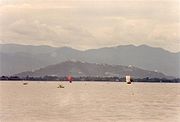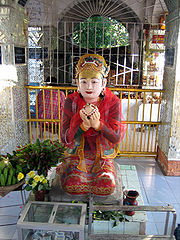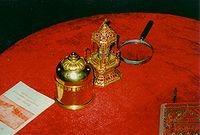
Mandalay Hill
Encyclopedia


Mandalay
Mandalay is the second-largest city and the last royal capital of Burma. Located north of Yangon on the east bank of the Irrawaddy River, the city has a population of one million, and is the capital of Mandalay Region ....
in Burma. The city took its name from the hill. Mandalay Hill is known for its abundance of pagodas and monasteries, and has been a major pilgrimage
Pilgrimage
A pilgrimage is a journey or search of great moral or spiritual significance. Typically, it is a journey to a shrine or other location of importance to a person's beliefs and faith...
site for Burmese
Bamar
The Bamar are the dominant ethnic group of Burma , constituting approximately two-thirds of the population. The Bamar live primarily in the Irrawaddy basin, and speak the Burmese language, which is also the official language of Burma. Bamar customs and identity are closely intertwined with general...
Buddhists for nearly two centuries. At the top of the hill is the Sutaungpyei (literally wish-fulfilling) Pagoda. A panoramic view of Mandalay from the top of Mandalay Hill alone makes it worthwhile to attempt a climb up its stairways. There are four covered stairways called saungdan leading up the hill from the south, southeast, west and north, and convenient seats of masonry work line these stairways all the way up. A one-way motor road today saves time and also makes it accessible for those who are unable to climb up the stairs, leading to an escalator and a lift to the pagoda at the summit.
Climbing Mandalay Hill

Chinthe
The Chinthe is a leogryph that is often seen at the entrances of pagodas and temples in Burma and other Southeast Asian countries. The chinthe is featured prominently on the kyat, the currency of Burma. The chinthe is almost always depicted in pairs, and serve to protect the pagoda...
s or leogryphs (stylised lion figures) stand guard at the southern and main approach at the foot of the hill, popularly known as the Chinthe hnakaung atet (two chinthes ascent). It is a gentle climb and there are many stops along the way, most importantly the hermit U Khanti's dazaung or hall where the Peshawar
Peshawar
Peshawar is the capital of Khyber-Pakhtunkhwa and the administrative center and central economic hub for the Federally Administered Tribal Areas of Pakistan....
Relics ( three fragments of bone of the Gautama Buddha
Gautama Buddha
Siddhārtha Gautama was a spiritual teacher from the Indian subcontinent, on whose teachings Buddhism was founded. In most Buddhist traditions, he is regarded as the Supreme Buddha Siddhārtha Gautama (Sanskrit: सिद्धार्थ गौतम; Pali: Siddhattha Gotama) was a spiritual teacher from the Indian...
) were kept from 1923 until after the Second World War when they were moved to a building at the foot of the hill and no longer on display. Leaving U Khanti's dazaung is by way of a tunnel lined by Hnakyeik shissu or the 28 Buddhas of the past and present worlds, or alternatively up a steep flight of steps next to the tunnel. Climbers will see plenty of stalls selling flowers, paper streamers, miniature pennants and umbrellas for the Buddha, and food and refreshment for visitors and pilgrims. All the dazaungs have frieze paintings, most of them from the late Konbaung dynasty
Konbaung dynasty
The Konbaung Dynasty was the last dynasty that ruled Burma from 1752 to 1885. The dynasty created the second largest empire in Burmese history, and continued the administrative reforms begun by the Toungoo dynasty, laying the foundations of modern state of Burma...
period; there is one depicting Awizi ngayè (Avici
Avici
In Buddhism, ' is the lowest level of the Naraka or "hell" realm, into which the dead who have committed grave misdeeds may be reborn...
Hell) in gory detail.
Farther up near the summit, a gigantic standing image of the Buddha called the Shweyattaw (literally standing) or Byadeippay (prophesying) Buddha with his right hand pointing towards the city. Legend has it that the Buddha once visited the place and prophesied that in the year 2400 of the Buddhist Era a great city would be built at the foot of the hill where his teachings would flourish. One curiosity that belongs to the myth surrounding the ancient kingdom of Bagan
Bagan
Bagan , formerly Pagan, is an ancient city in the Mandalay Region of Burma. Formally titled Arimaddanapura or Arimaddana and also known as Tambadipa or Tassadessa , it was the capital of several ancient kingdoms in Burma...
is the so-called 'Kyanzittha's spear mark' near the top of the hill. He was supposed to have executed a miraculous pole vault using his spear across the Irrawaddy!

Stupa
A stupa is a mound-like structure containing Buddhist relics, typically the remains of Buddha, used by Buddhists as a place of worship....
is the image of the ogre
Ogre
An ogre is a large, cruel, monstrous, and hideous humanoid monster, featured in mythology, folklore, and fiction. Ogres are often depicted in fairy tales and folklore as feeding on human beings, and have appeared in many classic works of literature...
ss Sanda Muhki who, for want of something to offer the Buddha, made an offering of her own breasts! And for this extreme act of merit the Buddha made the prophecy that Sanda Muhki would be reborn as a great king who would built a city at the foot of the hill and become a great supporter of Buddhism in the year 2400 of the Buddhist Era (1857 AD), the year King Mindon
Mindon Min
Mindon Min was the penultimate king of Burma from 1853 to 1878. He was one of the most popular and revered kings of Burma. Under his half brother King Pagan, the Second Anglo-Burmese War in 1852 ended with the annexation of Lower Burma by the British Empire. Mindon and his younger brother Kanaung...
laid the foundations of Mandalay. On each of the four corners of the terrace can be seen a king of the ogres with his army of miniature ogre images behind him paying obeisance to the Buddha. There are also images of various creatures, one at each level before a Buddha image, such as a rabbit, a cockerel or a lizard, representations of the Buddha's innumerable rebirths during his cycle of Samsara
Samsara
thumb|right|200px|Traditional Tibetan painting or [[Thanka]] showing the [[wheel of life]] and realms of saṃsāraSaṅsāra or Saṃsāra , , literally meaning "continuous flow", is the cycle of birth, life, death, rebirth or reincarnation within Hinduism, Buddhism, Bön, Jainism, Sikhism, and other...
(birth, suffering, death and rebirth).
At the summit

Zayat
A zayat is a Burmese building found in almost every village. It serves primarily as a shelter for travelers, at the same time, is also an assembly place for religious occasions as well as meeting for the villagers to discuss the needs and plans of the village. Theravada buddhist monks use...
s (rest houses), various stupas around such as the Kuthodaw Pagoda
Kuthodaw Pagoda
Kuthodaw Pagoda is a Buddhist stupa, located in Mandalay, Burma , that contains the world's largest book. It lies at the foot of Mandalay Hill and was built during the reign of King Mindon. The stupa itself, which is gilded above its terraces, is high, and is modelled after the Shwezigon Pagoda...
and its 729 satellite stupas each housing a page inscribed in stone the world's largest book
World's largest book
The world's largest book stands upright, set in stone, in the grounds of the Kuthodaw pagoda at the foot of Mandalay Hill in Mandalay, Myanmar . It has 730 leaves and 1460 pages; each page is three and a half feet wide, five feet tall and five inches thick...
(the entire Pali
Páli
- External links :* *...
Buddhist Canon
Tripiṭaka
' is a traditional term used by various Buddhist sects to describe their various canons of scriptures. As the name suggests, a traditionally contains three "baskets" of teachings: a , a and an .-The three categories:Tripitaka is the three main categories of texts that make up the...
), Kyautawgyi and Sandamuni Pagodas, the Irrawaddy to the west and the Minwun Hills on its opposite bank, the road to Madaya and Mogok to the north, and the Shan Yoma range of mountains to the east. There is yet a final stop down the northern slope immediately after the Sutaungpyei Pagoda called the Mwegyi hnakaung (Two Great Snakes) Pagoda. It has the images of two great cobras that were believed to frequent the hill to pay their obeisance to the Buddha and above these images seated are those of two Nat
Nat (spirit)
The nats are spirits worshipped in Burma in conjunction with Buddhism. They are divided between the 37 Great Nats and all the rest . Almost all of the 37 Great Nats were human beings who met violent deaths . They may thus also be called nat sein...
s that they became when they died. Pilgrims stuff bank notes in the cobras' mouths and pray. The Champac
Michelia champaca
Magnolia champaca is a large evergreen tree, native to the Indomalaya ecozone . It is best known for its strongly fragrant yellow or white flowers. It is, however, primarily cultivated for its timber, and is also used in urban landscaping...
, with its fragrant white blossoms on branches like candelabra, grows wild on the hill, along with the crimson red flowers over the feathery foliage of the Flame tree
Royal Poinciana
Delonix regia is a species of flowering plant from the Fabaceae family, Caesalpinioideae subfamilia, noted for its fern-like leaves and flamboyant display of flowers. In many tropical parts of countries around the world it is grown as an ornamental tree and in English it is given the name Royal...
. Sunset over the river and the western hills as seen from Mandalay Hill can be a wonderful experience, and crowds of tourists may be encountered in the evenings enjoying it.
World War II

In March 1945 the British Fourteenth Army
British Fourteenth Army
The British Fourteenth Army was a multinational force comprising units from Commonwealth countries during World War II. Many of its units were from the Indian Army as well as British units and there were also significant contributions from West and East African divisions within the British Army.It...
's Indian 19th Infantry Division under the command of Major-General Thomas Wynford 'Pete' Rees
Thomas Wynford Rees
Thomas Wynford Rees CB, CIE, DSO & Bar, MC, DL was an officer in the British Indian Army during World War I, the interwar years, World War II, and post-war.-Early life and career:The son of the Reverend T. M...
, dubbed the 'Pocket Napoleon' by his men on account of his size and successful military career, was closing in on the Japanese in Mandalay where resistance was based mainly at Mandalay Hill with its pagodas and temples honeycombed for machine-guns, well supplied and heavily garrisoned. Fort Dufferin or the walled city with the royal palace was another pocket of resistance by the remaining Japanese troops. A Gurkha
Gurkha
Gurkha are people from Nepal who take their name from the Gorkha District. Gurkhas are best known for their history in the Indian Army's Gorkha regiments, the British Army's Brigade of Gurkhas and the Nepalese Army. Gurkha units are closely associated with the kukri, a forward-curving Nepalese knife...
battalion stormed up the hill engaging in fierce hand-to-hand fighting all day and night on the 9th of March, and they were joined the next day by two companies of a British battalion.
The Japanese stood firm and the last defenders had to be blown out from the cellars by rolling down petrol drums and igniting them with tracer bullets. It was not until the 11th of March that the hill fell into British hands. Aerial bombardment was resorted to when shelling from the hill failed to breach the city wall and destroy the enemy, and Mandalay Palace
Mandalay Palace
The Mandalay Palace , located in Mandalay, Myanmar, is the last royal palace of the last Burmese monarchy. The palace was constructed, between 1857 and 1859 as part of King Mindon's founding of new royal capital city of Mandalay. The plan of Mandalay Palace largely follows the traditional Burmese...
, a national heritage of great importance, burnt down during the siege. Whether it was the shelling and bombing or the enemy that destroyed the splendid teak palace was never determined with any certainty.

